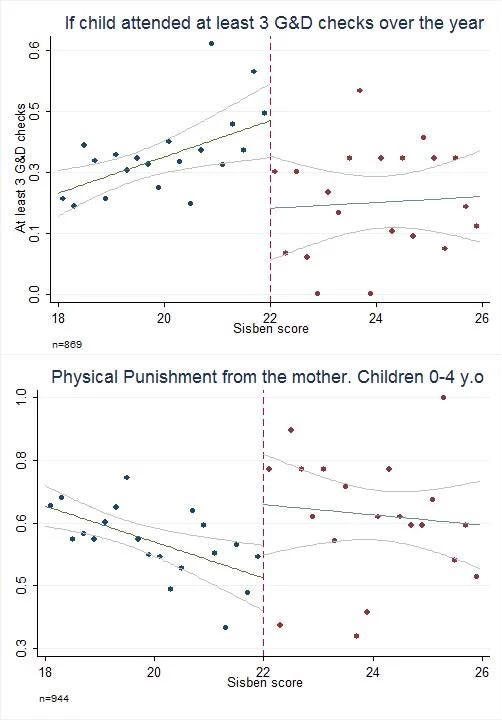This is the sixth post in our series of blogs by graduate students on the job market this year.
Interventions during early childhood have begun to gain importance in the social policy agenda in developing countries. These interventions have been mostly designed to address health, nutritional and cognitive deficiencies; and have shown to positively impact children’s development and nutritional outcomes, as well as socio-emotional abilities (Schady, 2006). Less evidence exists on the impact on discipline practices and spousal violence, factors that also affect children’s development. Experiencing or witnessing violence as a child appears to have important effects latter in life (UNICEF, 2014). Children who experience violence are more likely to drop out of school, to engage in adult criminal behavior and to become maltreating parents, among others. Studies have pointed out that physical violence against children is common throughout the world, and violence at home is the most common form of violence against children (Pinhero, 2006). For the particular case of Colombia, the three most common ways parents use to discipline children are verbal reprimand (76%), hitting with objects (44%) and slaps (28%) according to the Demographic Health Survey (DHS, 2005). Despite these figures, parenting practices remains a topic that has not received a lot of attention from researchers in developing countries.
My job market paper sets out to start filling this gap by exploiting the quasi-experimental variation in access to different social programs in Colombia. A large set of social programs, focused on young children, are targeted using a proxy means index. Using two different approaches of causal inference, I find evidence of a change in parents’ disciplining practices due to social programs targeted to young children. Fathers and mothers use less physical punishment, while mothers also increase the frequency of the use of pedagogic ways of discipline, such as explaining the importance of obeying or sending the child to another room in the house.
Health Checks and Child Discipline
A large set of social programs in Colombia are targeted using a proxy means index, called Sisben. The proxy means index is a function of a set of household demographic characteristics, consumption of durable goods, capital endowments and current income, it ranks from 0 to 100 and six levels are defined. Population in levels 1 and 2 are eligible for a large set of early childhood interventions, which includes child care options, nutritional programs and a health care plan including health checks (growth and development (G&D) checks). G&D checks cover three components, an educational content for parents, development and growth. In the educational content for parents, topics such as nutrition, early stimulation, parenting, and prevention and management of frequent illness are addressed. Parents are told about the importance of not using physical punishment and are taught alternative strategies to discipline children. I exploit the discontinuity on the probability of benefiting from these programs by implementing a regression discontinuity design (RDD). I use the DHS (2005) in Colombia and use the Sisben Index as the forcing variable. DHS only provides information for two of these programs, G&D checks and Hogares Comunitarios de Bienestar (HCB). Though the likelihood of benefiting from both programs decreases after the eligibility threshold, a significant discontinuity is only found for G&D checks.
The graph shows the likelihood a child aged 0-4 years attend at least 3 G&D checks over the year (top panel), and the likelihood a mother uses any kind of physical punishment (such as slaps, hitting and pushing) with children in this age range (bottom panel); as a function of the Sisben score. The results show that children in households above the Sisben 2 threshold (above Sisben score 22) are indeed less likely to attend G&D checks, particularly they are 30 percentage points (pp) less likely to attend at least 3 G&D checks over the year. Analyzing then the impact on physical punishment, I find that there is a 20 pp increase in the use of physical disciplining by fathers and mothers of children who attend less regularly the G&D checks. Impact is driven by practices used with children 0 to 4 years old. The magnitude of these impacts should be interpreted having in mind the influence that other programs may have, though I'm not able to check for a discontinuity in all of them.
A Subsidized Child Care Option and Child Discipline
HCB is a subsidized care option, where a Madre Comunitaria (Mother from the Community) hosts 12 to 14 children, from 2 to 5 years old. Children who attend a HCB have to follow a routine during the time they are in the Hogar, and their parents are invited to attend bi-monthly talks on topics such as parenting, domestic violence and nutrition, among others. To estimate the impact of HCB on child discipline, I estimate a propensity score matching (PSM) using different lengths of exposure to the program. I eliminate a first set of concerns about selection into the program, by comparing children who have been exposed to the program 16 months or more, to those that have been only exposed 2-15 months (see Bernal and Fernandez (2012) for more information on the impact of the program). For this strategy, I use the data collected in 2007 for the evaluation of the program.
Results show that mothers of children who have been exposed to the program at least 16 months use less physical punishment and more pedagogic ways, as compared to mothers of children that have only been exposed 2-15 months. In particular, mothers decrease the use of physical punishment by 3 pp, when the child does not want to obey; and increase the frequency of the use of pedagogic ways of discipline by 4 pp, when the child does not want to eat or to obey.
The difference in magnitude between the two strategies should be read having in mind the difference between the samples. The PSM uses only children who are attending a HCB; while the RDD uses poor population very close to the threshold, which is not the poorest among the poor.
Mechanisms
To interpret these findings, I suggest that the interaction with parents seems to be essential for changing their behavior; either because they become more aware that punishing physically is bad, or because they acquire better parenting skills. Attending a HCB or G&D checks on a regular basis can make parents “feel bad” about the possibility that doctors, nurses or Madres Comunitarias find out the child has been physically punished. For the particular case of HCB, the program appears to increase the frequency in which the mothers use alternative ways of punishment, suggesting they may be learning better parenting practices. Evidence does not seem to support a change in children’s behavior.
Readers might be concerned by the fact I'm using self-reported data instead of observed data. We may think that treated parents under report the use of physical punishment because they are aware it corresponds to a bad behavior, though they do not necessarily stop using it. Even if this is the case, the results at least suggest that social programs are changing the awareness of how bad is to punish children physically, which can be seen as a first step. The reader should also note that the purpose of DHS is not to target social programs, which reduces the concern of a systematical relation between under reporting and program participation.
Policy Implications
Results found in this paper shed some light on an outcome not analyzed much in early childhood development studies, child discipline. Evidence provided here shows that early childhood interventions addressing mainly health, nutrition and cognitive development have an extra benefit on parenting behavior. This raises the question of whether or not interventions focused more on parenting can further boost these impacts. Social programs can help parents in low-income households improve their children’s outcomes through improved parental practices.
Diana Lopez-Avila is a PhD student at Paris School of Economics and is on the job market this year.



Join the Conversation